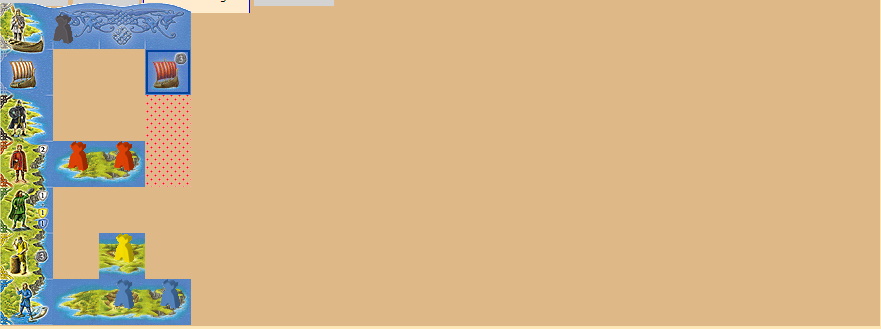Vikings is a board game that is always on my ‘wish to play’ list..
Well, I got the chance, in a browser on my PC!
Vikings is a fast economic game. Despite the nominal “Viking” theme, no actual exploration or pillaging is involved.
This is the ACTUAL quote used to sell the game on BGG!
Vikings Game Play
Each player takes a start tile ‘Homeland’ thing that is a big L shaped bit of cardboard and a bit of gold depending on the player count. Players also take 2 cubes of the same colour and put one on their Homeland to denote their colour and one on 10 points.
Shuffle the tiles face-down into 6 stacks of 12 tiles and put the Vikings in the bag.
The game lasts for 6 rounds each of 5 phases:
1 – Lay Out Offerings: Place island tiles and Vikings around the wheel in a certain order. Islands in the lowest space, ships in the highest and the Vikings by colour. Blue in the lowest space then Yellow, Green, Red, Black then Grey. This creates 12 pairs of tiles and Vikings.
As I played the digital version, it was a row not a wheel.

2 – Acquire Set: In turn order, players MUST pay the cost (shown a the top) in Gold to take a set of tiles and Vikings. The 0 cost set cannot be taken until the Viking in 0 is the only one left of that colour.
3 – Move Wheel: When 0 is taken, turn the wheel to adjust the cost of all the remaining available pairs. In the digital version, the cost on the row is updated rather than rotated.
Placing Islands & Vikings
4 – Place Tile: You place the tile in your Homeland based on many, many placement rules.
- Ship tiles go on the first row only, there is a ship on it to remind you
- Ships go next to other ships (Except for the first one obviously)
- The first three columns must be full before starting column 4
- Island tiles must be adjacent to another island tile or the Homeland tile and placed the right way up
- Artwork must match on adjacent tiles, land to land, sea to sea.

5 – Place Vikings: The Viking is then placed on the newly placed land tile, or the Homeland.
The Viking can only be placed on the new tile if the Island was placed in the colour row matching the Viking otherwise it goes on the Boatsman space off the board. Grey Vikings, who are boatsmen, always go on the Boatsmen space.
These 5 steps are repeated until all the sets are taken, then there is some scoring which oddly comes in two sizes.
Scoring
After rounds 1, 3 and 5 you have small scoring. Each player earns 3 gold for each (yellow) goldsmith Viking on an island not “threatened” by a Ship. (Any ship that does not have a (black) warrior in the same column under it)
After rounds 2, 4 and 6 you have big scoring. For each Boatsmen you have, you can move 1 coloured Viiking from your Boatsmen area to the correct row if there is an island space available, discarding the boatsmen.
For each ship repelled by a Warrior, collect the bounty for that ship.
Un-Threatened (red) nobles on an island tile gets 2 victory points.

Un-threatened (green) scouts get 1 victory point if on an island and 1 victory point for each goldsmith and (blue) fisherman on tiles directly below the scout.
Goldsmiths (Un-threatened of course) on an island tile earns 3 gold coins.
A new round starts with the start player going clockwise, the game ends after 6 rounds then there is a bit of final scoring.
Ships that do not have a warrior assigned are not repelled and cost their bounty value, paying 1 point for each unpaid gold.
1 point for each 5 gold which you trade with the supply (Leftover gold is the tiebreaker)
The player with most boatsmen on their Homeland gets 10 points
The player that has made the most completed Islands gets 7 points and the player with the longest Island gets 5
Then you feed your people. Count all Vikings on your Islands & Homeland. Each unthreatened, Island-based fisherman can feed 5 of your Vikings. Gain 2 points for each fed Viking and lose 1 for each unfed.
The player with the most points is the winner with left over gold the tie-breaker.
Theme
I mean, the blurb says it all. There is no pillaging or anything like that.
I do like the interesting focus on the jobs of the non-fighty Vikings, something that most games miss out on. But I didn’t care about what I was doing thematically. I was putting coloured things in places to score points.
Components & Artwork
The physical components look standard. However, the cardboard dial used to change the value of sets of Vikings and Islands looks pretty nice. Better than a digital row of blobs for sure.
The art is very ‘2007 board game’.

Ease of Teaching & Accessibility
Jebus, No, this game is a nightmare!
The litteral only advantage is that everything is 100% open information so you can help people on their turn. Explainging the scoring could be an issue. I would 100% check BGG for a crib sheet if I was teaching this game.
Vikings Summary
This is one of those games I constantly tried to get in maths trades for a while when I did them. It looked ‘quite good’ but not so good that I wanted to buy a brand new copy.
Having played it, I’m glad I didn’t get it in either way really.
I mean, it’s an OK puzzle trying to build those islands and tactically place and combo your Vikings but it’s nothing special. It is a 14-year-old game at this point so I am taking this into account.
But I do have to say, that at its core, it’s basically Kingdomino with extra steps, it’s Isle of Skye but less fun. It’s Carcassonne with less interaction.
It’s not to say it’s terrible just that to be a competitor in the mid-weight Euro game right now you need to be special, and it isn’t, it’s just ‘OK’.
Jesta ThaRogue



Leave a Reply